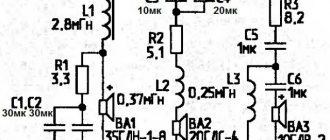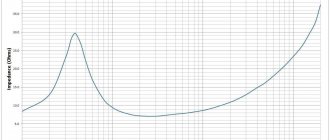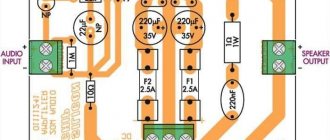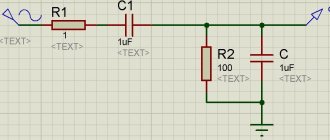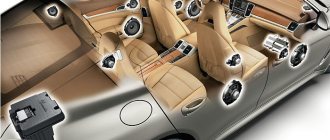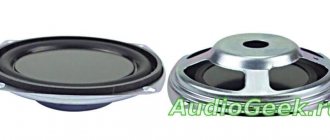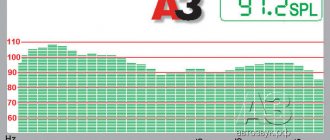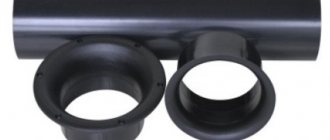- home
- →
- Radio engineering of the 19th and 20th centuries (TVs, acoustics, optics, etc.)
- →
- Acoustic systems, speakers, loudspeakers by USSR manufacturing plants
- →
- Acustic systems
- →
- post-war speaker systems
- →
- plant Red Ray mountains. Red ray Lugansk region. Ukraine acoustics CLIVER
- →
- acoustic systems produced at the Krasny Luch plant
Search:
buy, sell Cleaver 75AS-001 (Krasny Luch plant), prices
Acoustic system Cleaver 75AC-001 (Krasny Luch plant)
Cleaver 75AC-001 is a three-way speaker system with a bass reflex. Produced by NPO Okeanpribor and . Designed for high-quality reproduction of music and speech programs in stationary living conditions. The recommended power of a high-quality household amplifier is 100 W. The preferred installation option is on a 0.3-0.5 m stand. A distinctive feature of the system is that it has a high level of characteristic sensitivity and the ability to withstand high electrical power values, which allows you to play programs with an extended dynamic range without noticeable distortion. The speaker body is made in the form of a rectangular non-demountable box made of chipboard, veneered with valuable wood veneer. The thickness of the case walls is 16 mm, the front panel is 24 mm. The design of the housing includes elements that increase the rigidity of the housing and reduce the amplitude of vibrations of the walls - stiffeners and couplers. The heads are framed with decorative overlays made of ABS-2020 plastic: the woofer head overlay is round, with six mounting holes, the midrange and treble head overlay is rectangular, with eight mounting holes. The midrange head is isolated from the inside of the total volume of the housing by a special sealed pipe connecting the front and rear walls of the housing. The internal volume of the speaker is 57 cubic dm. The design of the filters uses resistors of the C5-35V type, capacitors of the MBGO type, and an inductor on plastic frames with “air” cores. The speakers use the following heads: - HF 10GDV-4 - HF 30GDS-1 - LF 100GDN-3 Technical characteristics: - Reproducible frequency range - 25-25000 Hz; — Uneven frequency response of sound pressure, at the lower limit frequency of the range relative to the level of average sound pressure — 19 dB; — Uneven frequency response of sound pressure, in the range of 100-8000 Hz — +-3 dB; — Level of characteristic sensitivity — 91 dB; — Nominal electrical resistance — 8 Ohms; — The minimum value of total electrical resistance is 6.4 Ohms; — Limit rated power — 100 W; — Maximum long-term power — 150 W; — Maximum short-term power — 300 W. Size: 386x710x340 mm; Weight: 30 kg.
| Date added: 2007-10-05 | |
In the previous article, we started a conversation about how you can independently modify domestic speaker systems in accordance with audiophile ideas about sound quality. The object for the experiment was the popular Soviet speakers 75AC-001, which still have a high reputation even among advanced listeners. As it turned out, after a relatively simple modernization that is not very burdensome for the family budget, they can sound very good. Judging by the letters from readers who still come to the editor, the topic of improving columns interested many of them, and therefore we decided to return to this issue again.
But first, for those who did not get their hands on No. 11 of the magazine for 1998, let us briefly recall the “contents of the previous series.” So, the 75AC speaker systems were conceived “smartly” and, in principle, should have sounded very decent. However, all the delights of mass assembly, design simplifications, suboptimal installation of the electrical filter board, terrible internal wiring, plus the presence, as it turned out, of unnecessary protection, completely “kill” the sound. Therefore, it is more correct to consider 75AC-001 (aka 150AC-001) as a good set of Do-It-Yourself construction parts. It includes fairly decent loudspeakers with high sensitivity, electrical filter elements (coils, capacitors, wirewound resistors), as well as a body blank veneered with natural veneer with holes already cut for the loudspeakers. Such sets are very popular abroad (here they were also sold in some showrooms and at Gorbushka), as they allow handy audiophiles to bring their ideas to life and at the same time save a considerable amount. Therefore, at the first stage of the upgrade, or more precisely, the tuning of the 75AC-001, they were completely dismantled, including the removal of all internal wiring, including connections on the filter board, and unnecessary components (protection devices and quenching resistors). Then, based on the remaining elements, the crossover filters were redesigned using an optimized circuit. At the same time, all internal installation was carried out with high-quality speaker cable made of oxygen-free copper.
To dampen standing and reflected sound waves inside the housing, sheets of fibrous sound absorber, used as a filter in kitchen hoods, were glued to the back and side walls. In conclusion, it was proposed to replace the steel “scoop” terminals with high-quality gold-plated “posts”. That, in fact, is all that was done at the first stage of work. Such simple and, in general, obvious improvements to the basic design had a very positive effect on the sound quality. The new version of the speakers was called 75AC-SE, and for some time they completely satisfied our requirements. However, after a series of tests, it became clear that although the Special Editions sound much better than their original version, they still do not reach the level of decent Hi-Fi. It has become obvious that the full potential inherent in these domestic systems is far from being exhausted. Gradually, the desire matured to take up the soldering iron again and finally bring them to mind. Moreover, by this time the author managed to modernize other components of the tract. In particular, the transistor switches that shunt the output in vinyl and CD players were removed, and reed switches were used instead; in addition, all internal wiring in the turntable was replaced, including the connecting interconnect cable.
Subtleties of articulation.
As before, before the start of tuning-II, a plan for its implementation was developed. As a first step, it was decided to try a two-wire connection to the amplifier using the bi-wiring method, since testing of foreign speakers had convincingly demonstrated its effectiveness. Then it was supposed to increase the damping of the LF and MF loudspeakers by increasing the amount of sound absorber inside the housing and in the midrange box. Finally, I wanted to achieve better articulation of the bass, which, although it became more collected after the first stage of the upgrade, still did not sound convincing enough. Actually, it all started with the bass, since it is the sound in the low-frequency range that causes the greatest complaints among 75AC owners. The reason for the “mumbling” in this case is quite obvious: the huge 100GDN-3 diffuser is too heavy to be effectively damped even by the ultra-low output impedance of the power amplifier. Under these conditions, there is only one way out - to influence it using acoustic methods, i.e. place an additional sound absorber inside. Deterioration in the sound of the 75AC at the low end can also occur due to the resonance of the woofer head moving away from the bass reflex tuning frequency. After 8-10 years of operation, the corrugation inevitably dries out and its flexibility decreases, which leads to an increase in the resonant frequency of the loudspeaker. Worse, this also changes the acoustic quality indicators of the 100GDN-3. So what should we do now? Irina Arkadyevna Aldoshina, who at one time led the development of 75AC-001, recommends experimentally measuring the parameters of the “aged” bass driver (resonant frequency in the open air Fs and total quality factor Qts) and using known methods to calculate the new tuning frequency of the bass reflex. Then tune it to a higher frequency, reducing the length of the pipe. You will have to cut off some of it with a hacksaw, but take your time, remember “cutting seven times” to experimentally make sure that the bass really improves after this. To do this, we recommend making two tubes up to 60 mm long from thick cardboard or other material (slightly more than half the length of the bass reflex - 104 mm), one of which should fit tightly into the other. The outer diameter of the outer one is 80 mm, which corresponds to the diameter of the port. After this, the standard bass reflex is removed from the speaker body. This is not difficult to do, since it is not secured in any way and is held in the hole on the front panel due to a tight fit. Then a cardboard “telescope” is tightly inserted into its place, and by changing its length, the most acceptable bass is achieved.
The optimum is best caught not by ear, but by the input impedance curve of the speaker. However, the experiments carried out in a real room of 20 square meters. m showed that the sound character of the 75AC at low frequencies when adjusting the bass reflex did not improve as noticeably as could be expected. Simply damping the port with plug inserts turned out to be much simpler and more effective. To do this, washers with a diameter of just over 80 mm are cut out of sheet foam rubber - preferably dark in color so that they do not contrast with the front panel - for reliable fixation in the pipe. The optimal thickness of the liner depends on the density of the material. It is best to take a sheet that is not very thick in order to be able to change the damping depth by installing several of these plugs. A sound signal with a high level of low-frequency components is supplied to the speakers, and by changing the number of earbuds, the highest quality bass is achieved. The easiest way to evaluate it is on a large drum (“kick”) or double bass, the sound of which should become much clearer. But don’t get too carried away, because if you plug the bass reflex port tightly, the latter will stop working altogether and the acoustic design will turn into a “closed box”. Which is not good, since 100GDN-3 was not designed for this. According to the author, the best results are obtained if, after installing the liners, the air flow intensity drops by approximately half. The total thickness of medium-density foam will be approximately 20-30 mm. This way it is possible to achieve the most successful compromise: the bass becomes more accurate and elastic, without losing too much in depth and intensity. It will be much easier to notice the effect if the high frequencies are “crushed” by the amplifier’s tone controls. It’s even better to listen to the low-frequency section separately by connecting the speakers using a two-wire circuit.
Game of four wires.
| Now the midrange will live here. Pasting with sound absorber the midrange loudspeaker pipe and stand. The same as above, plus gauze mat No. 2 (art. text.) Sockets for bi-wiring from the outside... ...and from the inside. "Minimalized" crossover. It is no longer possible to simplify any more - all unnecessary things have already been soldered off. Contact? There is contact! |
Thus, we smoothly approached the next stage of the upgrade - organizing a bi-wiring scheme. For it you will have to purchase three meters of acoustic cable made of oxygen-free copper OFC. Taking into account the high power of the speakers, the recommended conductor cross-section is at least 2.5 - 4 sq. mm. It is believed that pure copper is preferable for wiring the low-frequency section, and silver-plated copper is better suited for mid/high frequencies. Now the market offers a huge number of all kinds of cables, and there is simply a limitless field for experimentation. In the author’s version, which gave good results, an OFC cable from Jamo with a cross-section of 4 mm (80-100 rubles/m) was used to connect the woofer, and a Vampire Wire OFC Speaker Cable with a cross-section of conductors of 2.5 square meters was used for the top and middle. mm (40-50 rub./m). They were also used for internal wiring in speakers. Next, you should consider purchasing quality input terminals. In principle, of course, you can do without them by soldering the cables directly to the input of the crossover filters. At the same time, a decent amount is saved and several contact transitions are avoided. But then you are practically deprived of further tweaking opportunities, i.e. selection of speaker cables (do not disassemble the speakers every time to replace them). In addition, sealing “tightly” is inconvenient, because Connecting speakers becomes more difficult due to the risk of getting tangled in coils of cable. Therefore, if you decide to tune the 75AC to the maximum, then do not skimp and take good gold-plated “screws”. Unfortunately, they are quite expensive: no cheaper than 300-400 rubles. for one pair (there are products from well-known companies, not Chinese consumer goods). Since each speaker with a two-wire connection requires 2 such pairs, bi-wiring them will cost a pretty tidy sum. Plus, you need to splurge on spade or banana connectors - 4 pieces each. for each cable. You will need 16 such connectors, and the price of each is, at best, about 30-40 rubles. This is how accounting works. However, if you have already upgraded your speakers to the 75AC-SE level, your costs will be halved, since you should already have half of the cables and connectors. The purchased connectors should be pressed onto the stripped ends of the cable of the required length. This is best done using a special crimping tool, but with some care, good results can be achieved using ordinary pliers. Once the cables are ready, you can begin to “open up” the speaker systems. We will assume that the starting point for tuning-II is the speakers of the 75AC-SE level. On the cover with connectors we install an additional screw pair for midrange/high-frequency loudspeakers. Then we remove the crossover board from the case. We disconnect the inputs of the mid-pass and high-pass filters from the low-pass loudspeaker circuit and connect them with separate cables to their own screw pair. (Please note that to reliably solder the copper conductors of a large-diameter cable, you need an electric soldering iron with a power of at least 80-100 W, so stock up on it in advance. Keep in mind that cold soldering can negate all your efforts to improve the sound quality.) Then we produce corresponding installation changes in filter circuits, i.e. we separate the “ground” circuits of each of the loudspeakers.
Actually, at this point the “electric” stage of tuning-II is completed. All further operations involve muffling the internal volumes of the housing to combat reflections of sound waves inside it. To do this, you will have to spend a little more money and purchase several sheets of fiber sound absorber (filter for kitchen hoods), one package of which today costs about 100 rubles. This material is necessary to absorb the energy of standing sound waves from the back of the diffuser. A sheet of porous polymer is rolled into a tube and glued to the inner walls of a cylindrical box that isolates the midrange loudspeaker from the rest of the volume. At the same time, in order to leave enough space for the 30GDS-1 “basket”, you need to retreat approximately 50 mm from the top edge of the box. To increase the degree of damping of the midrange driver, it is a good idea to place a small mat of loose cotton wool on the “bottom” of the sound absorber pipe (cotton balls are also suitable). After this, the same sound absorber inside the speaker body (through the hole for the subwoofer) should be used to cover the outer surface of the bass reflex pipe and the isolating box of the midrange speaker, as well as the wooden spacer stand between the rear and front walls. Then you need to sew another mat from gauze, into which approximately 0.8-1 kg of cotton wool is loosely stuffed. Mat #2 is placed between the wooden spacer and the midrange box at the top of the cabinet. In this case, it should be fixed (with glue, using buttons or shoe nails) on the side walls and on the spacer so that the mat covers approximately half the clearance of the body height. Clearance is necessary so that the sound wave from the back of the 100GDN-3 can easily penetrate the upper half of the body. At the same time, the presence of a sound absorber ensures effective dissipation of the energy of sound waves reflected from the upper wall of the housing. Particular attention should be paid to ensure that mat No. 2 does not block the bass reflex hole. In order to avoid unwanted overtones under the influence of sound waves from the woofer, try to hide the wires from the midrange and tweeters under a layer of sound absorber. As a last resort, they can simply be fixed on the side walls.
Feel the difference.
OK it's all over Now. Now you can assemble the speakers (which we, by analogy with the tuning depth indexing system introduced by Ken Ishiwata at Marantz, will assign the code 75AC-SE mkII) and begin testing them. If your amplifier has two pairs of speaker output terminals, it makes sense to connect the cables to different pairs. Moreover, many amplifier models provide the ability to switch loudspeakers connected to it, which makes it possible to separately listen to the sound of speakers in both the low- and mid/high-frequency ranges. Before you start listening, make sure that the polarity of all speaker connections in the speakers is correct. With correct speaker phasing, the sound source when playing a mono program or recording pink noise should be exactly between the speakers. It’s also a good idea to “buzz” the speakers with a sliding tone signal in the frequency range 20-20000 Hz (tracks 16-18 on the CD “Ours in the City!”, supplement to “AV Salon” No. 3/98). The sound volume of the speakers should be more or less uniform throughout this range, excluding the lowest frequencies. If something seems suspicious to you, double-check that the filters are installed correctly and the phasing of the speaker connections is correct. If you don't have this or another test CD, then simply listen to a recording you are familiar with to see if there are any anomalies in the sound.
After carrying out the “qualification tests”, we launched the test in full: we listened to a wide variety of sound material - from heavy metal to classical music and instrumental jazz. And what do we hear? According to the first (always the most correct) impression, the naturalness and sound resolution of the 75AC-SE mkII at mid frequencies has increased almost by an order of magnitude. On vocals, for example, not only the subtlest nuances of the manner of performance became clearly audible, but also the breathing of the singers, the rustle of clothes and other quiet sounds that previously, in most cases, the “old” 75AC (even the SE versions) were simply ignored. The high ones, figuratively speaking, have become “thinner than a human hair” and louder than a Valdai bell. If earlier the sound of brushes on plates was simply pleasing, now it delights: you can even hear how individual wires slide along the surface of the plates. And what is the sound of the triangle of a symphony orchestra worth? The bass also picked up and almost got rid of the “mumbling”. Although, in fairness, we admit that it was still not possible to achieve from the 75AC the same clear sound at the low end as from imported high-end Hi-Fi stereo systems. However, perhaps a fair share of the blame for this lies with the room itself, since good acoustics of listening rooms in audio equipment stores is achieved only after special treatment of their walls and floors. The size of the listening room is also important: in small ones (especially square ones) it is very difficult to achieve clear bass due to the standing sound waves that inevitably arise in them. Therefore, even from very good and expensive speakers it is rarely possible to hear truly correct bass in a real living room. By the way, for preventive purposes, it is useful to “buzz” the room where your stereo system “lives” from time to time with a sliding sound tone. At the same time, the resonances of glass bookcases, the clinking of dishes and other similar parasitic sounds are perfectly revealed. Indeed, under normal conditions they are masked by the sound of music, but are subconsciously perceived by the brain as “dirt.” If such defects are discovered, the room must be “cured.” For example, coat the clinking glass in the closet and windows around the perimeter with mastic or sealants, put rubber rings under the shelves with dishes, etc. If there are pronounced resonances in the frequency range of 100-500 Hz, try changing the location of the speakers in the room and “hum” it again. The unevenness of sound at high frequencies and their excessive brightness can be reduced by hanging a carpet opposite the speakers on the wall and placing a rug on the floor. If, on the contrary, the room is overly muffled and there is a catastrophic lack of highs, use the HF tone control in the amplifier and compensate for these losses.
Well, now is the time to enjoy the sound of the 75AC SE mkII speakers, which you may not immediately recognize - it will be so transformed. Taking into account the obvious improvement in sound quality, the cost-effectiveness of speaker tuning is beyond doubt. Indeed, otherwise, to achieve an adequate level of sound quality, one would have to buy new imported speaker systems costing no less than $450-600.
PS. After you “figure out” the speakers, you will probably have a desire to further improve the sound of your stereo system. Now is the time to use the author’s proposed search method for finding “bottlenecks” (“Catching fleas scientifically”, “AV Salon” No. 3/99) and identify which of the components is now the weakest link. With an increased class of speakers, it may turn out to be a signal source or an amplifier. A completely reasonable question arises: why not improve them too? Moreover, our magazine has already published articles on “cold,” “warm,” and “hot” upgrades of Hi-Fi components (for example, “The best is the enemy of the good,” “AV Salon” No. 2/99). It is possible that in the near future the editors will return to this topic again. In the meantime, we wish you success in the noble task of upgrading and tuning your Hi-Fi equipment. After all, nothing pleases the heart of a true audiophile more than the sound of his own stereo system, which he has perfected.
PPS Before starting the complete dismantling of the speaker, we advise you to once again soberly assess your qualifications and decide whether you are capable of such a labor feat.
Konstantin Bystrushkin, Salon AV
